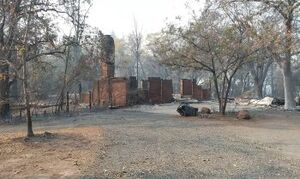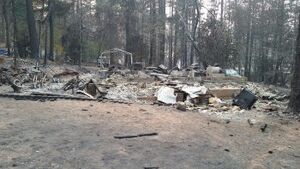Paradise
In those days when I heard the word Paradise it meant something much different to me than it did to most people. It meant that old house on Sunset Way under the deep oak trees, with the dogwoods blooming underneath and the ground thick with poison oak. It meant Whiskey Flats on a hot summer day and the serpentine rocks. It meant the place where we lived once with the O'Rourkes. It meant the Polivkas and their house. It meant sitting down in the Polivkas house and listening Jaro speak with his thick Czech accent and his slow, deliberate speech. It also meant seeing Betty and her latest art projects.
They lived about an hour and a half away and my parents still owned that house on Sunset Way which they rented out. I think it was Betty that got my mom so interested in art. My mom was what I consider to be permanent beginner when it came to art. Not necessarily a bad thing but certainly not a way to impress others. Always the student and never the teacher. And Betty was her teacher if anyone was. I'm not sure how much of the attraction that surrounded their house in Paradise was attributable to Betty and how much to Jaro. When my parents went to visit their friends they took me and my little brother Andrew along with them...I usually hated visiting their friends. There was the long conversations which did not include us. They seemed to go on forever while me and Andrew tried not to be bored. It was worse if there were kids our age; always that awkwardness being thrown together, even though by the end of the visit we were usually having fun.
But going to the Polivka's house was something I looked forward to. It was like entering a different reality, a kind of mysterious realm which hinted at some kind of esoteric knowledge. There was so much to look at and explore. Most of my parents' friends houses were very ordered and boring for the most part. But the Polivka's house had a very organic and chaotic quality to it. As though it was something that had grown up out of the earth and then furnished through inspiration. It also had a huge yard surrounding which offered infinite possibilities for exploration.
They did have kids but they were so much older, they were really adults to us. This was one of the things that was so unique about the Polivka's. Their children were not governed by the same set of rules as other families. Their children did not have the normal oppositional relationship with their parents that most kids have even as adults. They were quite happy sitting down and having an intelligent conversation with their parents, with other adults in the room. There was also the unspoken assumption that Andrew and I were part of this mostly adult conversation. When we spoke we were listened to and questions were asked of us at times. We were not condescended to, ignored and shunted off into some other room as we usually were.
We would leave from Fair Oaks in the morning, my parents always got an early start. Then we would make our ritual stop at the Dairy Queen in Marysville for an ice cream. When we drove into Paradise I would try to pick out sights I still remembered from when I lived there as a five year old: my old kindergarten, the house where the O'Rourkes lived, the Shell Station with the large Green Stamps sign. That Shell Station was across the street from where my mom was parked on a small incline, leaving my little brother and I alone in the car very briefly. My little brother released the parking brake and we rolled back into some kind of wall .
Usually we would stop by the house on Sunset Way before going to the Polivka's. That house was under a thick canopy of tall oaks, dogwoods and assorted trees. When we turned off the main road and drove downhill on a dirt road filled with potholes. It was the upper end of a deep dark ravine, thick with trees. There were a number of roughly built houses down this road, spaced a good distance apart. Mrs. Jones, my first babysitter lived down this road. My mom told us that her grandson was killed by a white shark when he was swimming off of Stinson's Beach. Andrew and I even found an article about it in a book we owned. Her son was at the beach with his girlfriend when he decided to take a swim out beyond the breakers. His girlfriend was on the beach while he was in the water swimming, when she saw that he was hit by the shark. Ignoring the danger she swum out and pulled him back to shore. He was bleeding profusely and did not survive for long. The girlfriend received an honorary medal of bravery from President Kennedy.
This was how I remembered the story, but after speaking with Peter recently, he remembered it slightly differently. He remembered that it was the beach near the Golden Gate Bridge and he didn't remember the girlfriend swimming out to attempt a rescue. Also it would have been before Kennedy was president so he wouldn't have given her a medal. So I tried to find a record of it on the internet and sure enough Peter was right, it was Baker Beach near the Golden Gate not Stinson's Beach which is much further north. Here is a link to a news article from the time May 7th 1959 The girlfriend did receive some kind of medal from President Kennedy a few years later, but they were swimming together when the attack happened.
My mom always warned Andrew and me never to mention this incident in front of Mrs. Jones...we never did.
Mrs. Jone's house had two handmade cement posts out front with dozens of gorgeous marbles set into the cement. My eyes were always drawn to these marbles, they seemed like such an embarrassment of riches. Also she had a long wraparound screen porch, that was dingy and uninviting, though she kept a collection of oddities back there. One of these oddities was a number of large paper hornets' nests, which I wasn't sure had been completely abandoned. Another thing I remember about that house, was watching “Yellow Submarine” on her smallish color TV. I remember finding it chaotic and slightly disturbing.
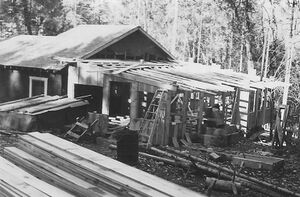
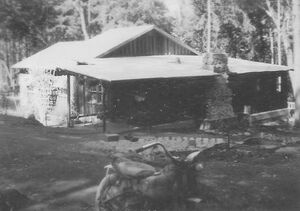
I didn't know it at the time but our house on Sunset Way was actually the first house Jaro and Betty lived in while in Paradise. The two couples had met a few years before. My Dad and Jaro both worked at the Board of Reclamation in Chico but they both lived in Paradise, a short commute. My Dad would have been about 26 and Jaro several years older. Betty and Jaro would have already had three children by that time. The two men got along together quite well, as did Betty and my mother. My mom and Betty used to go "Whiskey Flats" together, a small swimming hole on a branch of the Feather River. They would drive their kids down a rather treacherous road to the river. It is where I learned to swim, as well as my two older siblings.
It turned out Jaro had built an addition to the house on Sunset Way. Construction was not his profession (he was a mathematician) so it had it's deficiencies, I only learned that from my Dad much later. Building codes on rural roads in Paradise in those days were most likely very lightly enforced. I always thought it was kind of a cozy house. It had a huge yard but it was mostly on a slope and covered in poison oak. I was very allergic to poison oak so I stuck to the well carved paths. At the top edge of the property there was a shed my dad called the “goat house” and a cherry tree that actually got enough sun at that end of the property to produce some cherries. Of course the driveway was dirt and it continued on for a distance past the house. It had become overgrown towards its end but there was a fascinating rusted body of some old car back in there. It was one of the old boat-type cars from the 1950's or maybe even 40's. It was the abandoned project of some past renter. The house itself was of very pragmatic unadorned design. Just a kind of get it done sort of job, but I do remember the fireplace being very nice, I think it was finished off with round river rocks. This house was probably not something Jaro would have bragged about, but I think it suited its propose of keeping the roof over the head of a very young family just fine.
When we approached the Polivka's house we drove up a long dusty driveway with Star- thistle on both sides. There were no other houses in sight by the time we parked in front of their house. On the right side was a large wooden building which would have been a garage filled with cars and assorted vehicular playthings if it had been in Fair Oaks, but here it was an art studio. This was a very intriguing concept. The Art Studio was constructed of a rough unfinished wood construction. But the main house was short and solid looking, it's color was reddish orange like the soil surrounding it. If you looked closely you could see it was put together with large bricks fitted together snugly with a matching colored mortar. It was an adobe house built with bricks made from the surrounding soil. It had been constructed by the Polivka's themselves, after they returned from some time in Mexico. Jaro had fashioned a mold, then mixing the mud in a large cement mixer and brick by brick they cast the soil into blocks letting them dry in the hot Foothill Sun. While they were building the house the family of six, two parents and four children, basically camped out on the site. At the time this might not have been that unusual, my parents wouldn't have thought twice about it. In fact when I was an infant my parents camped out on a site near Frenchman Dam in northeastern California, while my Dad worked as an engineer during its construction. They had three kids at the time, including me.
The tent the Polivka's lived in had been my grandfather's. He and my Dad lived in it while my grandfather worked as a road surveyor. He lived in Alameda during the winter and traveled around California during the summer. My Dad often accompanied him. According to my Dad he remembers the tent as being very dirty, I'm not sure if he meant it was dirty before the mud brick building project of afterwards. Camping out in Paradise had the added danger of rattlesnakes. I remember stories of snakes killed on the Sunset Way property, because that was what everyone would do back then if they spotted a rattlesnake near where they lived and children played. There was a spot in the road in front of Mrs. Jones house where my older brother fell while riding his bike not far from a big rattlesnake. Peter told me that they killed thirteen rattlesnakes while they were building their adobe house. Many of them were babies which can be just as deadly as full grown snakes. When they dug the ground for a foundation, they came across several Native American (of course they called them "Indian" then) artifacts, which I think I remember seeing around their house. There was also a spring nearby which was very useful and maybe the reason why there was an Indian encampment in that spot.
I'm not sure how long their house building project took but it was well thought out. Jaro had fashioned diagrams showing each room in the planned house, not exactly architectural renderings but very well done. The end product was a home that seemed to rise up out of the ground, welcoming you in. I'm not sure how much Jaro was influenced by early California Mission design but it was remarkably similar in feel. The color of the adobe mixed with the use of large beams of wood made for a very earthy aura. I was taken back in time to that earthy aura the last time I visited the Carmel Mission.
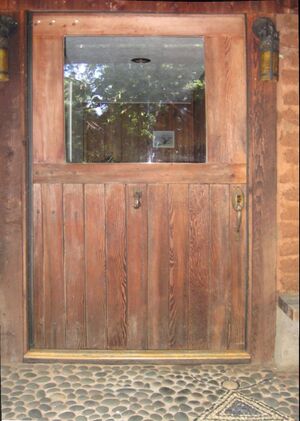
When we approached the house you were greeted by a very large wide front door, that was clearly fashioned by hand. I recall it being a split door where the top half could be opened separately from the bottom half. It was an impressive thing, standing at the top of a couple of cement steps with metal knocker in its center. Embedded in the steps were round river rocks, fashioned in a particular pattern. I thought it was some kind of stick figure. It was clearly the front door and clearly the door we were supposed to knock on as visitors, but it was a little intimidating. Still, I liked to be the one who used the metal door knocker. I liked the feel of it in my hand, it was a very smooth heavy metal ball held by a metal hand, kind of a subconscious inducement to use it to knock with. It's sound was not as satisfying as its feel and appearance, it made a kind of dull clanking metal sound.
It was usually Jaro who came to the door, so you had to be patient. Jaro was a tall, large man with an expressionless face and white hair. He was always wearing his unfashionable glasses. He had a foreign air about him, even beyond his accent and a far off stare in his eyes. His skin was shade darker than my dad's, who always got a good tan. He didn't bother with polite cheerfulness when greeting us. But somehow through his far-off stare you could tell he was glad to see my parents nonetheless. Though he was probably less enthused about us kids. Betty was usually busy working, she and my mom had that in common, being always busy. Though Betty was a bit calmer than my mom. My mom was always one to answer the phone after the first ring and quick to answer the front door bell. When you walked into their house, you first walked through a short hallway. On the right side of the wall hung a series of color photographs. They were photos of items which were not necessarily thought of as beautiful or even significant. Nor were they family portraits, they were photos of overlooked items one might see on a walk through an old abandoned farm, a rusty door hinge or a weathered, lichen covered piece of wood. The photos were framed in a shiny silver metal frame, this presentation and the subject would have been very cutting edge in the sixties or even early seventies. I think it was Jaro who was behind those photos.
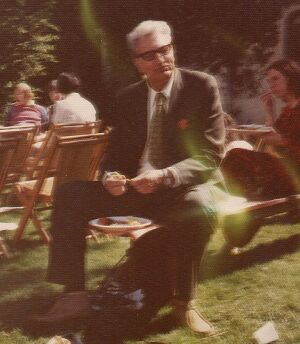
As you walked into the main living room there was a scent that welcomed you. It was a slightly musty smell with a hint of acrid, like a fine wine. If I were to breathe a bit of that air today I would be overwhelmed with a sense of calm, easy-going earthiness. My best guess is that it was a mixture of raw fabrics, wood, and the Paradise dirt. There was hardly a piece of plastic or factory-made scented goods in that house. In the main living room it was clear that the fireplace was an important fixture, it occupied the most prominent place. It had a high raised hearth and I seem to remember a cast iron pot hanging down from a chain which might have been used for cooking at times. However our visits to the Polivikas were usually during the summer months so I don't recall seeing the fireplace in action. The fireplace was on the East facing wall between the kitchen table where there were plenty of windows and the living room which was dark but inviting. There were no big easy chairs or over stuffed couches in this house. Each chair or bench had its own unique personality, its wood grain showing its color and texture and the fabric adding color, comfort and design. The padding may have been a bit deficient but the ingenuity was in surplus. All the furnishing were colored in earth tones shades of brown, yellow or red. Apparently this was all handmade furniture which they had purchased in Mexico, and them kept in storage until their building was complete. On a shelf opposite the fireplace was a collection of pottery Betty had made. One item stands out in my memory; it was in the shape of a over-sized salt shaker. On it's side was written in the clay in small type, “for a California Barbecue” then in larger type “O-Reagan-O”.
Occasionally if we stayed into the night, Jaro might pull out his projection screen along with his reel to reel projector or a slide-show. On one occasion Betty showed us a film of how to make RAKU pottery. I found it interesting enough to remember some details after all these years. The process was similar to the ways the very earliest peoples made pottery. After shaping your container and letting it dry, basically you dug a hole in the ground and built a fire right on top of it. Letting the coals be the kiln and letting some of it get blackened in a very nice uneven way.
The modernity of the projector could be imagined as incongruent with the handmade furnishing: but no, here it was a perfect fit, a less passive answer to a TV. There was a small TV hidden away in a small dark corner of the living room and this did seem like a bad fit, a kind of hidden vice. On one visit Betty actually turned it on and watched a show with us. It was PBS, a series of European animation shorts with a sound track but no words. They were probably Eastern European, maybe even from behind the Iron Curtain, they had a haunting defeated quality to them. It was a long ways from the Gumby style clay animation I was used to. They were moving in their own mournful way; as art can be at times and accompanied by discordant music.
Jaro had his own films he liked to show on his reel to reel projector. There was a homemade film he showed us once. The Polivika kids were in it, though they were much younger, around high school age. It also featured a stuffed owl as part of the storyline. The stuffed owl I recognized from their house, they kept it in their attic room. I also recognized a number of the scenes as taking place outside their house. Possibly the storyline was a take-off on the Maltese Falcon, it is a bit fuzzy in my memory, but I was very impressed that Jaro could make a movie. I thought it was something outside the realm of anyone but a whole crew of professionals. His skill at innovation and invention, along was the fact he could speak about six different languages made me think of him with a kind of awe.
Betty I also admired, but I saw her as more of a kindred spirit. When she spoke to me I imagined that she thought of me as a younger version of herself. She also had red hair and freckled skin. I never thought much of it as a kid, but as I've aged I've gotten the sense that redheads are wired a little differently. There is a bit more uneasiness, a little more vulnerability and difficulty in fitting in. Maybe that is where the bully/comic/geek stereotypes come from, that is the redheads' way of trying to fit in. She fit none of those stereotypes. Betty was apparently of similar genetic makeup as my mom and myself, though my mom had darker hair she also had very fair skin. There were clearly some strong Celtic genes in her not so distant past, maybe Scotch, Irish or Welsh. My mom's parents were both Scottish. She also seemed to share with my mom a kind of uncowed quality, a stoic kind of determination. She had enough confidence, to take up any number of life paths that went against the grain of modern society. She wasn't chatty or confrontational, but she wasn't going to let imagined judgments of others interfere with her doing what she loved to do. My mom must have seen her as a mentor or a fellow traveler; sometimes at little of both probably. They were both women who took on the traditional female roles just before those traditions began to change, they each had four children and served the central role in raising those children. But their roles in their respective families were anything but subservient. It always seemed that my mom was behind most of the major decisions in our family. I always assumed it was the same for the Polivkas, but now I'm not so sure. Jaro might not have been as willing to let go of the reins as my father was. The idea of building your own home on a piece of undeveloped property, kind of a homestead, seems more appealing to a man's imagination, than a woman's. But then Betty had some very unique approaches to how she went about living her life.
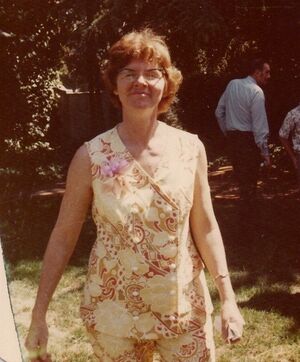
My dad, Betty and I were having a conversation, at one point when the topic of exercise came up. She said she played golf for exercise. She went up to the local public golf course and played about nine holes of golf. The walking around was her exercise. My Dad seemed surprised and amused because he hadn't take her for the golfer type. My dad who knew only a little about golf asked her what kind of clubs she used. She explained that she only used one club. This seemed odd even to me. Then he asked her what kind of a club she used, and she did not even know the name of the type of club she was using. After a bit of good natured confusion about what type of club she was using, she went to a nearby room and brought “the club” to show us.... It was a putter. I saw my Dad smile broadly imagining how she managed to play nine holes of golf on a real golf course using only a putter. Rolling the ball across the grass ten yards for each stroke. She must have gotten a fair share of resentful stares from the other golfers. I think she mentioned she always went when it was the least crowded and had to let the other golfers play through frequently.
(About this small memory. Peter told me only recently that he is in possession of Betty's “set of golf clubs”. So he wonders about that memory, was she messing with us? I couldn't say, but it was a clear memory for me. Possibly she was just getting started and was learning to play? Or maybe she had a whole set but just enjoyed using the one club for simplicities' sake? )
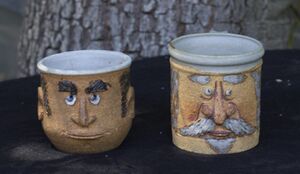
In her art studio she had a potter's wheel where she made a variety of clay objects which she had fired in a kiln somewhere else. The design which drew my attention was a series of mugs. They were large, well constructed with a hefty handle. The interior was finished with a thick, light colored glaze and the exterior she left was a unfinished light colored clay. Each mug had a different face on the side opposite the handle. Each face was an exaggerated observation of some unique personality. She showed us about a dozen completed mugs in her art studio one day and she gave a couple to my mom (my mom might have paid for them, she was an art patron when she could afford it). I wanted to make mugs just like she had done. My mom bought me a potter's wheel and I made some concerted attempts. But I discovered that it took a lot of practice, more than I had patience for as a kid, I soon lost interest. But mostly I remember her art as being watercolor landscapes. They were neither realistic nor impressionistic, they straddled the border between. A very classic watercolor style, but very personal at the same time. It brought you the feeling of the place through her eyes. There was a lightness to them, bright without being too happy.
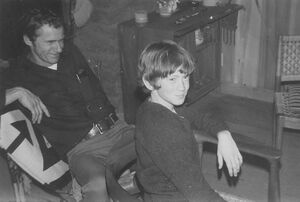
My mother used to have one of her paintings hanging in our house. Along with those of some of her other friends who were also artists. I always thought of Betty's painting as the kind of measuring tape of what other artists should be trying for. After spending untold hours viewing art and talking with artists, I realize that was a pretty naïve outlook. Every artist has their own story they are telling with their art, there is no one “right” way of doing art. Just as the is no one “right” way of living one's life. Though in the back of my mind I still think of Betty as the quintessential artist.
Whenever I see a Catalpa tree with it's long seed pods I am transported to the back porch of that adobe house. They had one growing beside the porch. A hammock was stretched between the Catalpa and a second large tree. I spent a few hours of a summer's day out on the back porch in that hammock. A large area of the back yard had been cleared of the manzanita, star-thistle and the other plants which tended to grow in open areas. It must have been maintained to some degree because there were no tall weeds but it was certainly not one of the heavily irrigated lush green lawns of Fair Oaks. There were a couple of peahens that wandered freely in the nearby woods that were also part of their large property. They were the closest things to pets Jaro and Betty owned. I only once caught a quick glimpse of them one day as they disappeared into the woods. Betty said they roosted high in some very tall trees at night to stay safe from roaming predators.
On a couple occasions I took short hike on one of the trails that led into the woods. It was an orange barked forest thick with manzanita with its limbs reaching off in all directions. Jaro took my Dad, Andrew and myself on a much longer hike to the edge of their property. It must have taken us about a half an hour to get there. Of course we were slowed by the woods which became very heavy at some points. Jaro wanted to show my Dad some ingenious method he had rigged up for hauling firewood out of some low lying portion of his property. He had to drag it up a very steep slope which my Dad found very fascinating, being an engineer. It was on this hike that Andrew had a plan to collect a small bundle of bay leafs. He thought he might be able to sell them at the small Natural Foods store in Fair Oaks. The powerful scent of the Bay Leafs gave both him and me headaches on the car ride back home.
Jaro had his own art that he created, I guess it was more of a craft than art because of its functionality. He would take the trunks of the manzanita trees that were about the width of a large arm, then he would cut them in about 6 inch sections. After drilling about ten holes in each of them downwards from the top they made excellent pencil holders. We had a few of these pencil holders in our household. I loved to rub the side of them and feel the smooth manzanita wood. I don't think Jaro even needed to sand them, the tree was just naturally smooth after the bark peeled off.
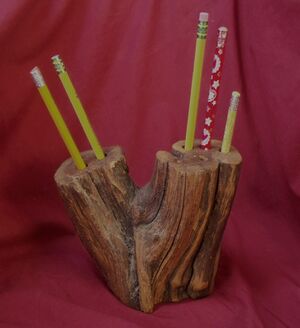
There was a small attic room up a set of very steep stairs. I have a foggy memory of spending a night in that room with Andrew when we were very young. The walls were the steep pitch of the roof line meeting at the top of the ceiling. I don't remember noticing this steep pitch from outside the house or even being able to see the roof at all. But from the inside I recall the shingles were nailed on directly to the roofing slates. The walls of this room were decorated with three or four African masks that seemed to have an eerie life of their own. Oddly I wasn't afraid of the masks but they also kept the stuffed owl in that attic which had been a very large and very real owl. Apparently it had been taxidermied by a friend and given to them as a gift, or an unwanted trinket. It wasn't so bad in the daylight but in the dark attic at night it was a frightful thing.
The kitchen was well placed just a few steps from the dining room. When entering the house from the back door which was also an extra wide door just like the front door, the dining room was on your right and the kitchen on your left. It was a wide roomy kitchen. It had a nice homey feel to it. The cabinets may have been painted, if they were they were one of the few things in that house that was painted. There must have been a refrigerator but I doubt there was a dishwasher, I remember seeing dishes drying on a rack on the counter. I only walked through it once or maybe twice. It was the domain of mothers who were in motion. Not a place for kids lingering or slow moving adults. But my mom spent a lot of time with Betty in the kitchen, it had plenty of room for both of them.
There was a dessert Betty made for us on one visit. She offered it to Andrew and me but we looked at it suspiciously. We thought of Betty as a healthy cook, the kind that used whole food ingredients with no mixes or packaged items. To us this meant something healthy disguised as a dessert. Her cooking skills evolved before the health food revolution which began in the late 60's and in 70's really took off. They seemed to be based more on real basic solid cooking traditions that went back millennia. Of course this kind of food was much more wholesome than Andrew and I could deal with. So when she offered us this dessert cooked in a metal sheet cake pan, we could clearly see there were walnuts in it, this made us hesitate. Overall it had a buttery sweet smell and there seemed to be a layer of something like frosting on it. She had made us an apple cobbler an a previous visit which we were familiar with, and it was delicious. So we gave this new thing a try... and it was the rich and sweet in just the right combination. It still holds a place in my memory as one the best thing I've ever eaten. Probably too sweet and rich for my adult palate but it changed my mind about “healthy” foods.
Of the four Polivka children, the three oldest were seldom seen around the house. They had gone off on their life journeys whether it was, to college on the East Coast or an Ashram in Berkeley I wasn't very clear. But I do remember my mom talking about how the Polivka boys were attempting to avoid being drafted and shipped off to Vietnam. Avoiding the draft was always a major topic of conversation whenever my mom was around draft age young men. I think she was trying to dig up ideas for me when my time came. John talked in length about his research and efforts toward achieving conscientious objector status. I remember the gist of the conservation being that no matter how strongly a person felt that killing another human was wrong regardless of the reason, that a conscientious objector status was very difficult to establish. It could be claimed if one belonged to an organized religious sect with a history of such belief. And it sounded as though one had to show they belonged to said faith for a long period of time, being a recent convert wouldn't do. My mom mentioned that he was eventually rejected from going to war because he was outspoken about his pacifists beliefs and the military didn't want someone like that mixing with the other draftees. Probably he had to do some alternative civilian service. I'm not sure how accurate my mom's take on this was because she didn't always have the patience to take the time to carefully understand things of this nature. But being drafted to fight a war against my will was very much on my mind as well.
Ann was the oldest, then it was Peter, then John and finally Elizabeth who still lived on a small cottage outside of the main adobe. Elizabeth being the youngest is the one I saw the most of. Peter and John happened to be visiting occasionally. I was struck by how much their manner of speech was similar to Jaro's, very deliberate and reservedly polite. Jaro however was full of a dry humor that was delivered with a straight face, which could be rather scathing. Neither Peter nor John seemed to have picked up his scathing demeanor or his accent. I don't recall ever seeing Ann at the adobe in Paradise. At first I was anxious about Elizabeth, worried that this was someone I would have to relate to on the level of a peer or as an adult that would ask a series of uncomfortable questions. When I was at home I could always hide in my closet, or my room when I was older, but at their house I had no escape. However I soon learned I had nothing to fear with Elizabeth. Where Peter and John had taken after Jaro, Elizabeth had taken after Betty, she was friendly without passing judgment or asking too many questions. Her manner of speech was very buoyant, in fact I found myself hoping she would make a rare appearance in the main house. I guess I had a teenage crush, she was quite beautiful with straight dark hair and light brown skin. On my last teenage visits to the Polivka's I brought a friend along with me. He was a childhood friend with whom I was beginning to sense a drifting apart. He seemed to be moving in the direction of most male teenagers I knew; drinking and talking crudely about girls. I was drifting toward being a loner, finding fewer and fewer friends I could relate to. On that visit, Elizabeth made an appearance in the main house in a light summery dress, it was a hot day. I very much noticed her on that day, coming in from the back door with the light streaming in behind her lighting up her skin. She had such gorgeous skin, a kind of honey colored brown. Then greeting us with a wide smile. But on the drive back home with my friend in the car, he commented that he didn't like the fact that she didn't shave under her arms. I didn't say so but I was offended by his remark, it was as though we had seen a beautiful sunset together and afterward he had remarked that the sky was too orange. To this day I can see her walking in the back door with the light streaming in from behind and the smile on her face; it is one of those small treasures I hold in my memory.
I recall on one of my last visits to their Adobe in Paradise. I was a young adult and I accompanied my parents. I walked into their house noticing that it was just like I remembered it, very little had changed. The same knocker still hung on their door. The same photos still hung on the wall in the hallway. The Oh-Reagan-Oh shaker still sat on the shelf. And the same smell still clung in the air which sent me back to my childhood memories. I hiked a little ways it the manzanita forest and looked at a half-built pond on the side of the yard. It was a years old project that Peter or John started but never finished. I tried to marinate myself in memories.
It wasn't long before Mom and Betty decided they would like to go somewhere to do a little sketching. It was decided we would all go down to “Whiskey Flats”, the swimming hole where together they took their children, so many years ago. To those two it must have had more significance than I realized at the time. To get there, it was a single lane road with a steep drop off on the sides, with the wreckage of old cars at certain places when you looked down the steep cliff.
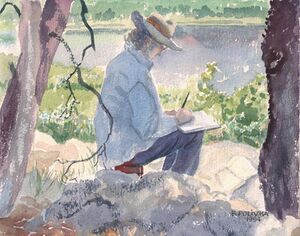
The old rusted cars where still there when we passed the steep cliff I remembered, as was the big green wall of Serpentine rock which overhung the road near that same place. But the swimming hole had changed quite a bit. It was full of people on this warm weekend. But it was a different kind of crowd then it was decades ago. There were small dredging rigs on the river with engines running continuously. There were some families, but they seemed to be living in campers at the swimming hole. There were nude couples sunning themselves. We did not feel comfortable in this scene. But undaunted, Betty and my Mom found a private place downriver from the old swimming hole. They broke out the pad of paper and pencils and began sketching. My dad sat on a rock with his shirt off, sunning himself. Betty complimented him on his physique and began to sketch him. I explored down river, stumbling on a nude sunbathing couple and a small dredge puttering away. When we returned to the Adobe afterward, we all felt an air of disappointment about how Whiskey Flats had changed. It was as though we had lost something. It was my dad who commented that it is a shame that nothing ever stays the same.
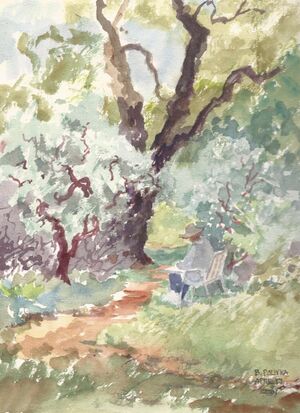
Throughout the years my mom and Betty would keep in touch. My parents continued to visit Jaro and Betty in Paradise. Sometimes my mom and Betty would get together for painting sessions, one time they met in Cornwall and spent some time together, painting scenes of skies, water and land. Betty was older than my mother by about ten years and she passed about ten years sooner. Friendships can last throughout the years, when there is a mutual unspoken magnetism. Their friendship lasted until the end. The magnetism that tied them together was art, my mom forever the beginner and Betty forever the teacher. They were a good pair.
Post Script:
In January or February of 2017 Peter and John Polivka paid us a visit in Santa Cruz. We had lunch on the wharf, my dad, my brother, myself and the Polivka brothers. I've always thought they had a fondness for both my dad and my mother and it felt like the timing of the visit was important, to John especially. During lunch he told us that he was battling pancreatic cancer but that the prognosis looked good. He had undergone the prescribed treatments and there were no signs of cancer.
I hadn't known or maybe I forgot that John was an early alum at UC Santa Cruz. He spoke with us a bit about his memories of Santa Cruz back in the early seventies. How many things had changed and how much had stayed the same. I later guessed that one of the main attractions of Santa Cruz for him was being close to the water and its access to sailing. Boating was one of the main undercurrents of his life. For most of his later life he lived on a houseboat in Sausalito.
Several months after their visit to Santa Cruz I heard that John's cancer had returned and it was now terminal with little chance of his recover. He died soon afterward. I was glad he was able to see Santa Cruz and my dad one last time.
The Polivka children held a service for John at the old adobe house in Paradise that the family built together. I attended that service with my Dad and learned some things about John and the Polivkas I hadn't know before. John had a great love for ships and sailing. He had also never married and I could tell from his youthful photos that he was especially good-looking. I remember my parents talking about how he went from girl-friend to girl-friend without ever sticking with one. They were all very nice people, in John’s view and according to his friends and family. My parents I believe, thought that not settling down with one person was a source of unhappiness for him, but I'm guessing it was not.
After John's service I received an email from Peter which I think adds to the story. Jack is my Dad's name.
John did the interior cedar v-groove paneling on the exterior adobe walls to cover them up when he was in his middle teens as well. We all pitched in for the concrete drive at the front of the house - except for Jaro who was off to Princeton for some coursework in higher math. I think he wanted to walk the halls that Einstein (his hero) walked years before.
I began writing down these personal memories of Paradise many years ago. Soon after I added this postscript, the Campfire burned down most of the buildings in Paradise, including the Adobe and our old house on Sunset Way, now called Quail Way. It is hard say much about my feelings surrounding this. How do I feel about losing something, that was lost to me many years ago anyway? I find it best to keep in mind those whose loss is now and those whose lives are upended. Though I can't help but feel a personal sadness when looking at these picture.
